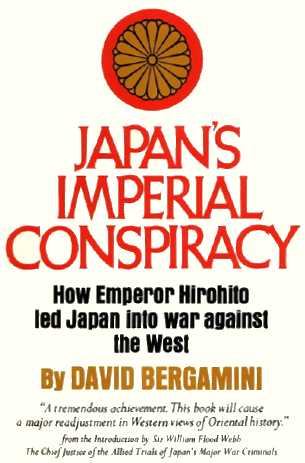Japan's Imperial Conspiracy
 | |
| Author | David Bergamini |
|---|---|
| Country | USA |
| Language | English |
| Subject | Internal Japanese politics before and during World War II |
| Genre | History |
| Publisher | Various |
Publication date | 1971 |
| Media type | Hardcover |
Japan's Imperial Conspiracy is a nonfiction historical work by David Bergamini. Its subject is the role of Japanese elites in promoting Japanese imperialism and the Greater East Asia Co-Prosperity Sphere; in particular, it examines the role of Crown Prince and Emperor Hirohito in the execution of Japan's Imperial conquest, and his role in postwar Japanese society.
The book concludes that the conventional conclusion of historical analyses - that the Imperial household was largely powerless and not culpable or particularly supportive of the imperial adventures, blame for which is assigned to military elites - is mistaken. Instead, it asserts that the internal political fighting necessary to gain support for imperialism was a long-premeditated plan supported by all sectors of the elite and especially by members of the imperial family.
The reason given as to why the American occupiers allowed the continuation of the institution of the Emperor is that its support was sought for the purposes of fighting Communism and the nearby Soviet Russia. Bergamini draws his conclusion from a variety of sources but gives prominence to his interpretation of various diaries kept by involved figures. His conclusions have not generally been accepted and his data and sources have been questioned.
Social Troubles Institute
The Social Troubles Institute, Social Troubles Research Center or simply Colonization Academy, which Bergamini alleged was founded in 1921, was a think tank dedicated to future conquest plans on the Asian Mainland, and their political implications. It had the patronage of Crown Prince Hirohito and was set up on land that had once been the Imperial Meteorological Observatory.
Bergamini describes the Institute as a secret indoctrination center (protected by extensive security measures) for select younger sons, of politicians, Japanese nobility and militarist supporters, who desired to participate in fulfilling the dreams of Imperial conquest harbored among elements of Japan's aristocracy. The first draft of Japanese conquest plans for world domination were traced by Bergamini to the Institute. Academics have generally considered Bergamini's research of his original sources to be contaminated by conspiracy theories, although his ideas have not entirely fallen out of circulation.
According to Bergamini's theory, graduates of this ultrasecret 'political' think tank, recruited only by special invitation from rightwing circles, continued its 'political' and 'military' practice in the occupation zones in Manchuria. From this 'school' began the political and strategic debate between the Strike North Group (the Army group, pro-war against Soviet Siberia) and the Strike South Group (the Navy group concerned with the Chinese lands and especially Southeast Asia).
The Director and principal academic adviser was Shūmei Ōkawa, with Mitsuru Toyama another 'professor' in the center. Both were adherents to the Black Dragon Society. This center was closed in 1945 by the Allied authorities.
References
- "From Our Correspondent: Hirohito and the War A conversation with biographer Herbert Bix" By Todd Crowell November 30, 2000 Web posted at 8:00 p.m. Hong Kong time, 7:00 a.m. EST
- "Imperial Conspiracy in Japan?" (in Review Articles). By Richard Storry. Pacific Affairs, Vol. 45, No. 2. (Summer, 1972), pp. 272–276.
- "Japan's Imperial Conspiracy, David Bergamini"; book review by Alvin D. Coox. The American Historical Review, Vol. 77, No. 4. (Oct., 1972), pp. 1169–1170.
- "Palace and Politics in Prewar Japan, by David Anson Titus", book review by Chalmers Johnson. The American Political Science Review, Vol. 71, No. 2. (Jun., 1977), pp. 802–803.
- "Palace and Politics in Prewar Japan, by David Anson Titus". Book review by Nathaniel B. Thayer. Political Science Quarterly, Vol. 90, No. 3. (Autumn, 1975), pp. 600–602.
- "Pearl Harbor Without Rancor: A German View; Pearl Harbor, 7. Dezember 1941: Der Ausbruch des Krieges Zwischen Japan und den Vereinigten Staaten und die Ausweitung des Europaischen Krieges zum Zweiten Weltkrieg. By Peter Herde". Book review by Hans L. Trefousse. Reviews in American History, Vol. 9, No. 4. (Dec., 1981), pp. 526–530.
Bibliography
- Bergamini, David (1971) [1971]. Japan's imperial conspiracy (Hardcover). New York: Morrow. pp. xxxviii, 1239 p. illus. 25 cm. LCCN 74102686.
- Bergamini, David (1971) [1971]. Japan's imperial conspiracy (Hardcover). New York: Morrow. pp. 2 v. (xlvii, 1612 p.) : ill. ; 22 cm.
- Bergamini, David (1971) [1971]. Japan's imperial conspiracy (Hardcover). London, England: Heinemann. pp. xxxviii, 1239, [1] p., 18 plates. illus., maps, ports. 24 cm. ISBN 978-0-434-06690-2. ISBN 0-434-06690-7; LCCN: 72176016.
- Bergamini, David (1972) [1971]. Japan's imperial conspiracy (Hardcover). New York: Pocket Books. pp. xlii, 1364 p. illus., ports. 25 cm.
- Bergamini, David (1971, 1972) [1971]. Japan's imperial conspiracy (Hardcover). London, England: Panther. pp. xxxviii, 1213 p. : maps ; 20 cm. ISBN 0-586-03842-6. (pbk.); ISBN 978-0-586-03842-0 (pbk.). Check date values in:
|date=(help); - Bergamini, David (2006 (?)) [1971]. Japan's imperial conspiracy: how Emperor Hirohito led Japan into war against the West (Hardcover). Lewiston, New York: Edwin Mellen Press. ISBN 0-7734-5894-8. (v. 1, bk. 1); ISBN 978-0-7734-5894-9 (v. 1, bk. 1); ISBN 978-0-7734-5896-3 (v. 1, bk. 2); ISBN 0-7734-5895-6 (v. 2, bk. 1); ISBN 978-0-7734-5895-6 (v. 2, bk. 1); ISBN 0-7734-5897-2 (v. 2, bk. 2); ISBN 978-0-7734-5897-0 (v. 2, bk. 2) LCCN: 200648238. Check date values in:
|date=(help); - Bergamini, David (1971) [1971]. Japan's imperial conspiracy (Hardcover). London, England: Heinemann,. pp. xxxviii, 1081, [31] p. : ill., maps ; 24 cm.
- Bergamini, David (1972) [1971]. Japan's imperial conspiracy (Hardcover). New York: Morrow. pp. XLII, 1364 p., [32] p. pl. : ill. ; 18 cm. LCCN 74102686.
- Bergamini, David (1972) [1971]. Japan's imperial conspiracy (Hardcover). London, England: Panther. pp. xxxviii, 1081, [29] p. : ill., maps, ports., geneal. ; 20 cm.